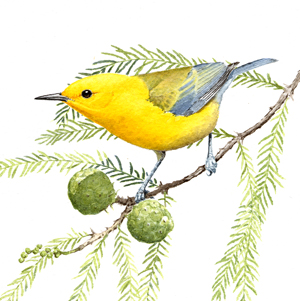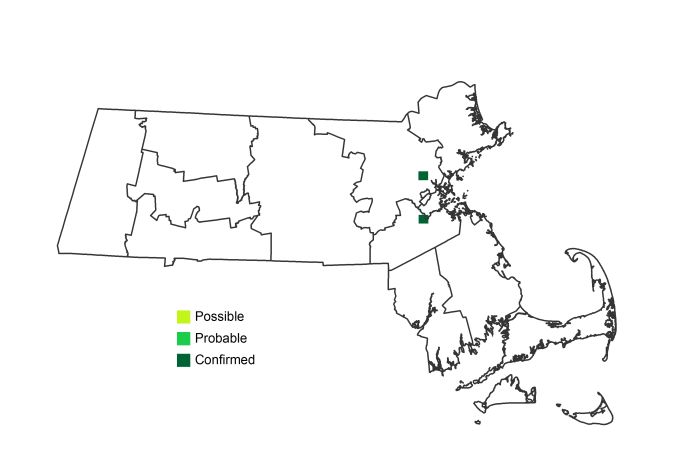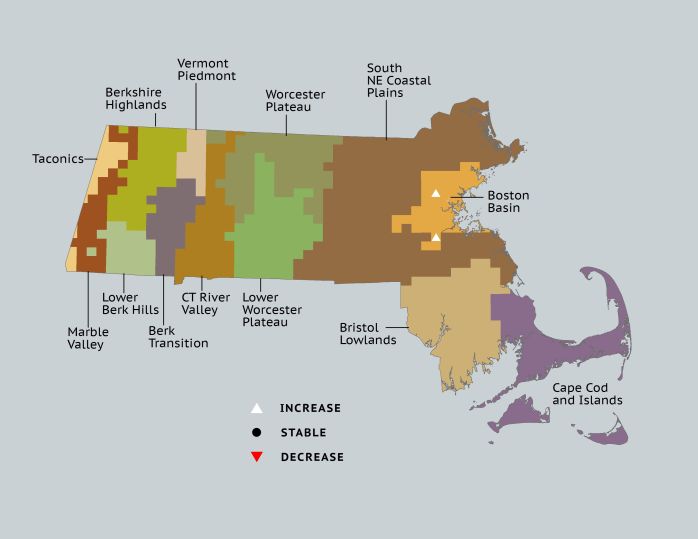Find a Bird
Prothonotary Warbler
Protonotaria citrea

Very local, trend not established
“I recall once they saw, to their great excitement, a Prothonotary Warbler.” – From the August 7, 1948, testimony of Whittaker Chambers before the House Committee on Un-American Activities
The bird that doomed Alger Hiss to imprisonment as a Soviet spy is always a bird to be excited about seeing, particularly in Massachusetts. Widely regarded as one of the handsomest warbler species in a family of very handsome birds, the Prothonotary Warbler is a denizen of southern wooded swamps. After a number of false starts and hopeful sightings, Prothonotary Warblers are, like the Cerulean Warbler, sending a vanguard to scope out Massachusetts.
Historic Status
Prothonotary Warblers leapfrogged over Massachusetts as they apparently expanded northward in the 1870s, and appeared in Calais, Maine, before being seen anywhere in the Bay State (Minot 1877). But Massachusetts records soon followed. One was shot “not before 1880” by a man in South Abington, which by that time was already known as Whitman. Three were shot in Northampton in 1883, and three more in Concord in 1886. Two of the three taken in Concord may have been breeding, but the historic record is silent on this detail. Another nineteenth-century specimen involved a singing male collected in Auburndale in 1890 (Howe & Allen 1901).
Atlas 1 Distribution
Regardless of the status of the 1886 record from Concord, the Prothonotary Warbler evaded detection throughout most of Atlas 1. In 1979 however, the final year of Atlas 1 fieldwork, a female Prothonotary Warbler built a nest in Hawley. No male was ever seen or heard in association with the nest, and the bird ultimately departed without laying eggs. While this is technically a Confirmation, the first bona fide nesting pair would come only after the close of Atlas 1.
Atlas 2 Distribution and Change
A Prothonotary Warbler nest was found during the inter-Atlas period in 1982 in Sharon, but the clutch was lost due to the interference of House Wrens (Petersen & Meservey 2003). With hard work and good fortune, Atlas workers Confirmed two more nests during Atlas 2, both in the Boston Basin. Even if the majority of Massachusetts residents have forgotten Boston’s swampland heritage, the warblers apparently did not, and perhaps these southeastern specialties will move into wooded wetlands elsewhere in the Commonwealth between the time of this writing and Atlas 3. Regardless, for the time being, the Prothonotary Warbler remains an extremely rare and local breeding species in the Bay State.
Atlas 1 Map

Atlas 2 Map

Atlas Change Map

Ecoregion Data
Atlas 1 | Atlas 2 | Change | ||||||
Ecoregion | # Blocks | % Blocks | % of Range | # Blocks | % Blocks | % of Range | Change in # Blocks | Change in % Blocks |
Taconic Mountains | 0 | 0.0 | 0.0 | 0 | 0.0 | 0.0 | 0 | 0.0 |
Marble Valleys/Housatonic Valley | 0 | 0.0 | 0.0 | 0 | 0.0 | 0.0 | 0 | 0.0 |
Berkshire Highlands | 0 | 0.0 | 0.0 | 0 | 0.0 | 0.0 | 0 | 0.0 |
Lower Berkshire Hills | 0 | 0.0 | 0.0 | 0 | 0.0 | 0.0 | 0 | 0.0 |
Vermont Piedmont | 0 | 0.0 | 0.0 | 0 | 0.0 | 0.0 | 0 | 0.0 |
Berkshire Transition | 0 | 0.0 | 0.0 | 0 | 0.0 | 0.0 | 0 | 0.0 |
Connecticut River Valley | 0 | 0.0 | 0.0 | 0 | 0.0 | 0.0 | 0 | 0.0 |
Worcester Plateau | 0 | 0.0 | 0.0 | 0 | 0.0 | 0.0 | 0 | 0.0 |
Lower Worcester Plateau | 0 | 0.0 | 0.0 | 0 | 0.0 | 0.0 | 0 | 0.0 |
S. New England Coastal Plains and Hills | 0 | 0.0 | 0.0 | 0 | 0.0 | 0.0 | 0 | 0.0 |
Boston Basin | 0 | 0.0 | 0.0 | 2 | 3.6 | 100.0 | 2 | 3.6 |
Bristol and Narragansett Lowlands | 0 | 0.0 | 0.0 | 0 | 0.0 | 0.0 | 0 | 0.0 |
Cape Cod and Islands | 0 | 0.0 | 0.0 | 0 | 0.0 | 0.0 | 0 | 0.0 |
Statewide Total | 0 | 0.0 | 0.0 | 2 | 0.2 | 100.0 | 2 | 0.2 |
Notes
The Prothonotary Warbler shows a significant decreasing Breeding Bird Survey trend in the Eastern US overall.



